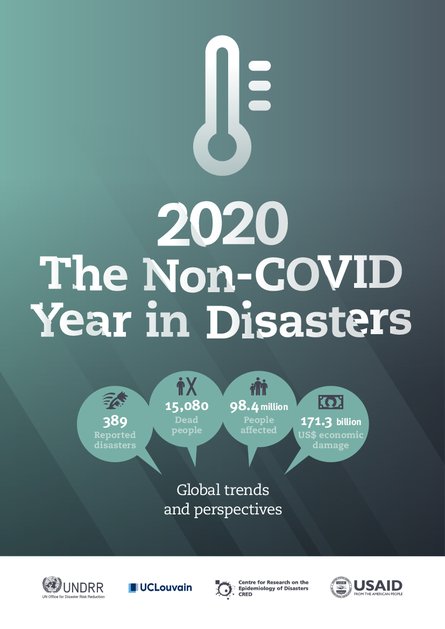
The year 2020 rivalled 2016 as the world’s hottest recorded year despite the absence of a strong El Niño effect. Apart from the COVID-19 pandemic, the year was dominated by climate-related disasters. These were largely responsible for the 389 recorded events which resulted in 15,080 deaths, 98.4 million people affected, and economic losses of at least US$ 171.3 billion. The statistics used in this report are drawn from the latest updates in the emergency events database, EM-DAT, maintained by the Centre for Research on the Epidemiology of Disasters (CRED, UClouvain).
At the outset, it is acknowledged that these statistics pale in comparison with the ongoing COVID-19 pandemic which by the year’s end had claimed almost two million lives, resulted in more than 90 million confirmed cases, trillions of dollars in economic losses, and “extreme poverty back up to levels not seen in a generation” as the UN Secretary-General has said.
In comparison to the previous two decades (2000-2019), 2020 was higher than the annual average in terms of number of recorded events and the annual average of economic losses, which is US$ 151.6 billion. There were considerably fewer deaths compared to the annual average of 61,709 and fewer people directly affected compared to the annual average of 201.3 million people. This decrease in impacts is due to the absence of mass casualty events, such as the 2004 Indian Ocean Tsunami (227,000 deaths) and the 2010 Haiti Earthquake (222,500 deaths) or high impact events, such as the 2015/2016 drought in India (330 million people affected). However, in 2020 there were 26% more storms than the annual average of 102 events, 23% more floods than the annual average of 163 events, and 18% more flood deaths than the annual average of 5,233 deaths.
This snapshot of the year in climate and geophysical disaster events does not consider the overlap with the impacts of the on-going pandemic. The additional losses inflicted by these reported events likely impacted those who have already suffered loss of income and employment because of COVID-19, particularly those in low- and middle-income countries. Unravelling the impacts of one from the other is a challenge and may have contributed to under-reporting of the impacts of non-biological hazards during the year under review. There is an existing problem of chronic under-reporting of economic losses from disasters, particularly from low-income countries.
The impacts of the events were not equally shared: Asia experienced 41% of disaster events and 64% of total people affected. Heatwaves in Europe accounted for 42% of total reported deaths. In a year of record-breaking storms and wildfires the Americas suffered 53% of total economic losses, largely in the USA which experienced the bulk of the year’s most costly climate-related disasters. Indonesia had the highest number of disasters (29 total events), including 25 floods. However, India and China suffered the largest human impacts with 19.6 million people and 14.9 million people affected, respectively. Floods were the most common disasters worldwide (201 events), while storms affected the highest number of people (45.5 million) and caused the most economic losses (US$ 92.7 billion). Extreme temperatures were the deadliest type of disasters accounting for 42% of total deaths, followed closely by floods which accounted for 41% of total deaths.